Lalibela
ላሊበላ | |
|---|---|
Town | |
Rock-Hewn Churches from top left: Church of Saint George; Biete Maryam; Biete Medhane Alem; Biete Abba Libanos | |
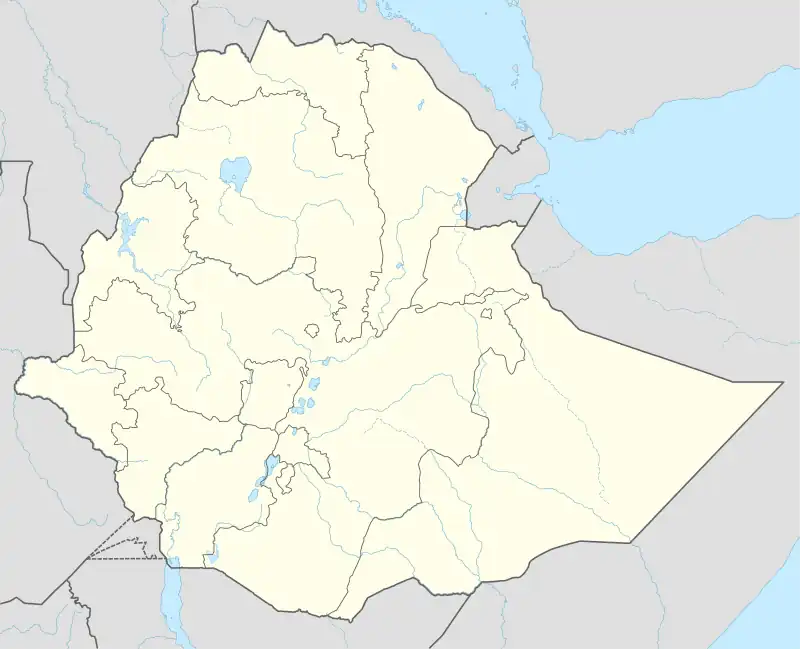 Lalibela Location within Ethiopia .svg.png.webp) Lalibela Location within the Horn of Africa  Lalibela Location within Africa | |
| Coordinates: 12°01′54″N 39°02′28″E / 12.03167°N 39.04111°E | |
| Country | |
| Region | |
| Zone | North Wollo |
| Population (2007) | |
| • Total | 17,367 |
| Time zone | UTC+3 (EAT) |
Lalibela (Amharic: ላሊበላ) is a town in the Amhara Region of Ethiopia. Located in the Lasta district and North Wollo Zone, it is a tourist site for its famous rock-cut monolithic churches. The whole of Lalibela is a large and important site for the antiquity, medieval, and post-medieval civilization of Ethiopia.[1] To Christians, Lalibela is one of Ethiopia's holiest cities, and a center of pilgrimage.
Ethiopia was one of the earliest nations to adopt Christianity in the first half of the 4th century, and its historical roots date to the time of the Apostles. The churches themselves date from the 7th to 13th centuries, and are traditionally dated to the reign of the Zagwe (Agaw) king Gebre Mesqel Lalibela (r. c. 1181–1221).[2]
The layout and names of the major buildings in Lalibela are widely accepted, especially by local clergy, to be a symbolic representation of Jerusalem.[3] This has led some experts to date the current church construction to the years following the capture of Jerusalem in 1187 by the Muslim leader Saladin.[4]
Lalibela is roughly 2,500 metres (8,200 ft) above sea level. It is the main town in Lasta, which was formerly part of the Bugna district. The rock-hewn churches were declared a World Heritage Site in 1978.[1]
History
Origins
According to local tradition, Lalibela (traditionally known as Roha) was founded during the Zagwe dynasty, under the rule of King Gebre Mesqel Lalibela (r. ca. 1181–1221 AD),[5] although it is more likely that the churches evolved into their current form over the course of several phases of construction and alteration of preexisting structures.[6]
There is some controversy as to when some of the churches were constructed. David Buxton established the generally accepted chronology, noting that "two of them follow, with great fidelity of detail, the tradition represented by Debra Damo as modified at Yemrahana Kristos."[7] Since the time spent to carve these structures from the living rock must have taken longer than the few decades of reign of Gebre Mesqel Lalibela, Buxton assumes that the work extended into the 14th century.[8] However, David Phillipson, professor of African archeology at University of Cambridge, has proposed that the churches of Merkorios, Gabriel-Rufael, and Danagel were initially carved out of the rock half a millennium earlier, as fortifications or other palace structures in the 8th century, during the days of the Kingdom of Aksum, and that Lalibela's name simply came to be associated with them after his death.[9] On the other hand, local historian Getachew Mekonnen credits Meskel Kibra, Lalibela's wife, with having one of the rock-hewn churches, Biete Abba Libanos, built as a memorial for her husband after his death.[10]
14th century
Abuna Bartolomeo from Egypt visited the churches sometime during the reign of Dawit I (1382–1413).[11]
15th century
Its name was first used in a European publication in Fra Mauro map made in Venice 1457-59, written as Lalabeda.[11]
16th century
A Portuguese priest, Francisco Álvares (1465–1540), accompanied the Portuguese Ambassador on a visit to Dawit II in the 1520s. After Alvares described the unique church structures he wrote: "I weary of writing more about these buildings, because it seems to me that I shall not be believed if I write more because as to what I have already written they may accuse me of untruth, therefore I swear by God, in whose power I am, that all that is written is the truth, and there is much more than what I have written, and I have left it that they may not tax me with its being falsehood. And because no other Portuguese went to these works except myself, and I went twice to see them from what I had heard of them. I swear by God, in Whose power I am, that all I have written is the truth". Although Ramuso included the plans of several of these churches in his 1550 printing of Álvares' book, it is unknown who provided him with the drawings.[12]

According to the Futuh al-Habaša of Sihab ad-Din Ahmad, Ahmad ibn Ibrahim al-Ghazi burned one of the churches of Lalibela during his invasion of Ethiopia. Sihab ad-Din Ahmad (Arab Faqih) provided a detailed description of a rock-hewn church "It was carved out of the mountain. Its pillars were likewise cut from the mountain." Ahmed then had a fire lit in the church and ordered "let one of yours and one of ours enter there".[13]
The next reported visitor to Lalibela was Miguel de Castanhoso, who was a soldier under Cristóvão da Gama and left Ethiopia in 1544. Castanhoso states: "There are here certain churches cut out of the living rock, which are attributed to angels. Indeed, the work appears superhuman, because, though they are of the size of the large ones in this country, they are each excavated with its pillars, its altars, and its vaults, out of a single rock, with no mixture of any outside stone. When the Moors overran this country they wished to destroy these churches, but could not either with crowbars, or with the gunpowder which they exploded in them, doing no damage at all."[14]
17th century
The Agaw of Lasta rebelled during the reign of Fasilides in 1637. The next year Fasilides marched into Lasta; according to James Bruce, the Agaw retreated to their mountain strongholds, and "almost the whole army perished amidst the mountains; great part from famine, but a greater still from cold, a very remarkable circumstance in these latitudes."[15]
21st century
In early August 2021, Tigrayan rebel fighters captured the town during the Tigray War.[16] On 1 December 2021, the Ethiopian army recaptured the town.[17] The town was recaptured again by Tigrayan forces on 12 December.[18] On 19 December, Ethiopian state media announced the town was recaptured for a second time, though it was unclear when.[19]
In early November 2023, Lalibela was the site of fierce fighting between the Ethiopian National Defense Force (ENDF) and Fano fighters.[20]
Churches
| UNESCO World Heritage Site | |
|---|---|
 The Church of Saint George, showing its base and walls | |
| Criteria | Cultural: i, ii, iii |
| Reference | 18 |
| Inscription | 1978 (2nd Session) |


This rural town is known around the world for its churches carved from within the earth from "living rock," which play an important part in the history of rock-cut architecture. Though the dating of the churches is not well established, most are thought to have been built during the reign of Lalibela, namely during the 12th and 13th centuries. Unesco identifies 11 churches,[1] assembled in four groups:
The Northern Group:
- Biete Medhane Alem (House of the Saviour of the World), home to the Lalibela Cross.
- Biete Maryam (House of Miriam/House of Mary), possibly the oldest of the churches, and a replica of the Tombs of Adam and Christ.[1]
- Biete Golgotha Mikael (House of Golgotha Mikael), known for its arts and said to contain the tomb of King Lalibela)
- Biete Meskel (House of the Cross)
- Biete Denagel (House of Virgins)
The Western Group:
- Church of Saint George, thought to be the most finely executed and best preserved church
The Eastern Group:
- Biete Amanuel (House of Immanuel), possibly the former royal chapel.
- Biete Qeddus Mercoreus (House of Saint Mercurius/House of Mark the Evangelist), which may be a former prison
- Biete Abba Libanos (House of Abbot Libanos)
- Biete Gabriel-Rufael (House of the angels Gabriel, and Raphael) possibly a former royal palace, linked to a holy bakery.
- Biete Lehem ("Bethlehem", Hebrew: בֵּית לֶחֶם "House of Bread").
Farther afield, lie the monastery of Ashetan Maryam and Yemrehana Krestos Church (possibly eleventh century, built in the Aksumite fashion, but within a cave).
The churches are also a significant engineering feat, given that they are all associated with water (which fills the wells next to many of the churches), exploiting an artesian geological system that brings the water up to the top of the mountain ridge on which the city rests.[21]
Vernacular architecture
In a 1970 report of the historic dwellings of Lalibela, Sandro Angelini evaluated the vernacular earthen architecture on the Lalibela World Heritage Site, including the characteristics of the traditional earth houses and analysis of their state of conservation.
His report described two types of vernacular housing found in the area. One type are a group he calls the "tukuls", round huts built of stone and usually having two stories. The second are the single-story "chika" buildings which are round and built of earth and wattle, which he feels reflects more "scarcity". Angel's report also included an inventory of Lalibela's traditional buildings, placing them in categories rating their state of conservation.[22]
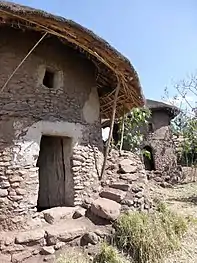 Tukul, two-story stone building
Tukul, two-story stone building.jpg.webp) Tukul showing exterior steps to second floor
Tukul showing exterior steps to second floor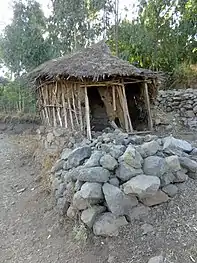 Chika, an earth and wattle building
Chika, an earth and wattle building
Other features
Lalibela is also home to an airport (ICAO code HALL, IATA LLI), a large market, two schools, and a hospital.
Demographics
According to the 2007 Census Data, the population was 17,367, of whom 8,112 were males and 9,255 were females.[23] Based on previous figures from the Central Statistical Agency in 2005, the town had an estimated total population of 14,668 of whom 7,049 were males and 7,619 were females.[24] The 1994 national census recorded its population to be 8,484 of whom 3,709 were males and 4,775 were females.
Gallery
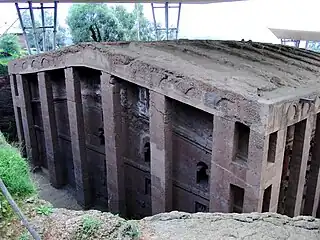 Bete Medhane Alem
Bete Medhane Alem Bete Amanuel
Bete Amanuel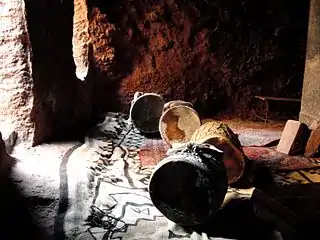 Ritual drums in a side track of Bete Giyorgis
Ritual drums in a side track of Bete Giyorgis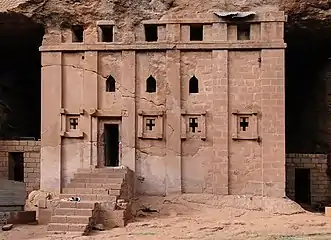 Bete Abba Libanos
Bete Abba Libanos Bete Maryam
Bete Maryam.jpg.webp) Priest with processional crosses at St. Mary's
Priest with processional crosses at St. Mary's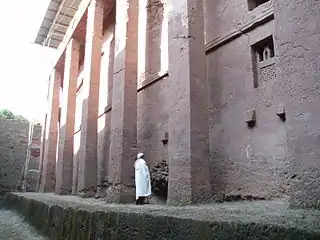 Man standing beside the walls of Biete Medhane Alem, believed to be the largest monolithic church in the world
Man standing beside the walls of Biete Medhane Alem, believed to be the largest monolithic church in the world Genneta Maryam
Genneta Maryam
Three-dimensional site scans of the Lalibela churches are also accessible online.[25]
See also
References
- 1 2 3 4 "Rock-Hewn Churches, Lalibela". UNESCO World Heritage Centre. Archived from the original on Dec 24, 2023.
- ↑ Windmuller-Luna, Kristen (September 2014), "The Rock-hewn Churches of Lalibela", Heilbrunn Timeline of Art History, New York: The Metropolitan Museum of Art, retrieved 27 July 2017
- ↑ Phillipson, David (2009). Ancient Churches of Ethiopia: Fourth-fourteenth Centuries. Yale University Press. p. 181. ISBN 978-0-300-14156-6.
- ↑ Phillipson, David (2009). Ancient Churches of Ethiopia: Fourth-fourteenth Centuries. Yale University Press. p. 179. ISBN 978-0-300-14156-6.
- ↑ Sani, Federico; Moratti, Giovanna; Coli, Massimo; Laureano, Pietro; Rovero, Luisa; Tonietti, Ugo; Coli, Niccolò (March 27, 2012). "Integrated geological-architectural pilot study of the Biet Gabriel-Rufael rock hewn church in Lalibela, northern Ethiopia". Italian Journal of Geosciences. 131 (2): 171–186. doi:10.3301/IJG.2011.26 – via Silverchair.
- ↑ Fauvelle-Aymar, François-Xavier; Bruxelles, Laurent; Mensan, Romain; Bosc-Tiessé, Claire; Derat, Marie-Laure; Fritsch, Emmanuel (2010-12-01). "Rock-cut stratigraphy: sequencing the Lalibela churches". Antiquity. 84 (326): 1135–1150. doi:10.1017/S0003598X00067132. ISSN 0003-598X. S2CID 130648151.
- ↑ Buxton, The Abyssinians (New York: Praeger, 1970), p. 110
- ↑ Buxton, The Abyssinians, p. 108
- ↑ "Medieval Houses of God, or Ancient Fortresses?" Archaeology (November/December, 2004), p. 10.
- ↑ Getachew Mekonnen Hasen, Wollo, Yager Dibab (Addis Ababa: Nigd Matemiya Bet, 1992), p. 24.
- 1 2 "Local History in Ethiopia" The Nordic Africa Institute website (accessed 29 November 2023)
- ↑ Francisco Alvarez, The Prester John of the Indies, translated by Charles Fraser Beckingham and George Wynn Brereton Huntingford (Cambridge: Hakluyt Society, 1961), p. 226. Beckingham and Huntingford added an appendix that discusses Alvarez's description of these churches, pp. 526–42.
- ↑ Sihab ad-Din Ahmad bin 'Abd al-Qader, Futuh al-Habasa: The conquest of Ethiopia, translated by Paul Lester Stenhouse with annotations by Richard Pankhurst (Hollywood: Tsehai, 2003), pp. 346f.
- ↑ De Castanhoso's account is translated in R.S. Whiteway, The Portuguese Expedition to Ethiopia (London: The Hakluyt Society, 1902), pp. 94–98.
- ↑ James Bruce, Travels to Discover the Source of the Nile (1805 edition), vol. 3, pp. 435-437
- ↑ "Lalibela: Ethiopia's Tigray rebels take Unesco world heritage town". BBC News. 2021-08-05. Retrieved 2021-12-20.
- ↑ "Ethiopian government says it has recaptured Lalibela, U.N. World Heritage site". Reuters. 2021-12-01. Retrieved 2021-12-05.
- ↑ "Tigray rebels retake Ethiopian heritage town of Lalibela". The Guardian. Agence France-Presse. 2021-12-12. Retrieved 2021-12-20.
- ↑ "Ethiopian military again controls religious town of Lalibela - media". Reuters. 2021-12-19. Retrieved 2021-12-20.
- ↑ "Ethiopian troops force armed group out of Orthodox holy site of Lalibela".
- ↑ Mark Jarzombek, "Lalibela and Libanos: The King and the Hydro-Engineer of 13th Century Ethiopia" (PDF), Construction Ahead, (May–June 2007): 16–21
- ↑ Odiaua, Ishanlosen. "Mission Report:Earthen architecture on the Lalibela World Heritage Site" (PDF). whc.unesco.org. UNESCO. Retrieved 25 July 2014.
- ↑ "The 2007 Population and Housing Census of Ethiopia: Statistical Report for Amhara Region"" (PDF). Central Statistical Agency. 31 May 2010. Archived from the original (PDF) on 19 January 2017. Retrieved 29 September 2016.
- ↑ CSA 2005 National Statistics Archived 2008-07-31 at the Wayback Machine, Table B.3
- ↑ "Site - Lalibela Rock-Hewn Churches". zamaniproject.org. Retrieved 2023-05-21.
Further reading
- David W. Phillipson, Ancient Churches of Ethiopia (New Haven: Yale University Press, 2009). Chapter 5, "Lalibela: Eastern Complex and Beta Giyorgis"; Chapter 6, "Lalibela: Northern Complex and Conclusions"
- Sylvia Pankhurst, Ethiopia: a cultural history (Lalibela House, Essex, 1955). Chapter 9, "The monolithic churches of Lalibela"
- Paul B. Henze, Layers of time: a history of Ethiopia (Shama Books, Addis Ababa, 2004). Chapter 3: "Medieval Ethiopia: isolation and expansion"
- Hancock, Graham, Carol Beckwith & Angela Fisher, African Ark – Peoples of the Horn, Chapter I: Prayers of Stone/The Christian Highlands: Lalibela and Axum. Harvill, An Imprint of HarperCollinsPublishers, ISBN 0-00-272780-3
- Popular Archeology - Through Pilgrim Eyes: The Creation of Significance
External links
- Dagmawi Lalibela: Stunning photos of a new African wonder – BBC 18th August 2023

.jpg.webp)

.jpg.webp)